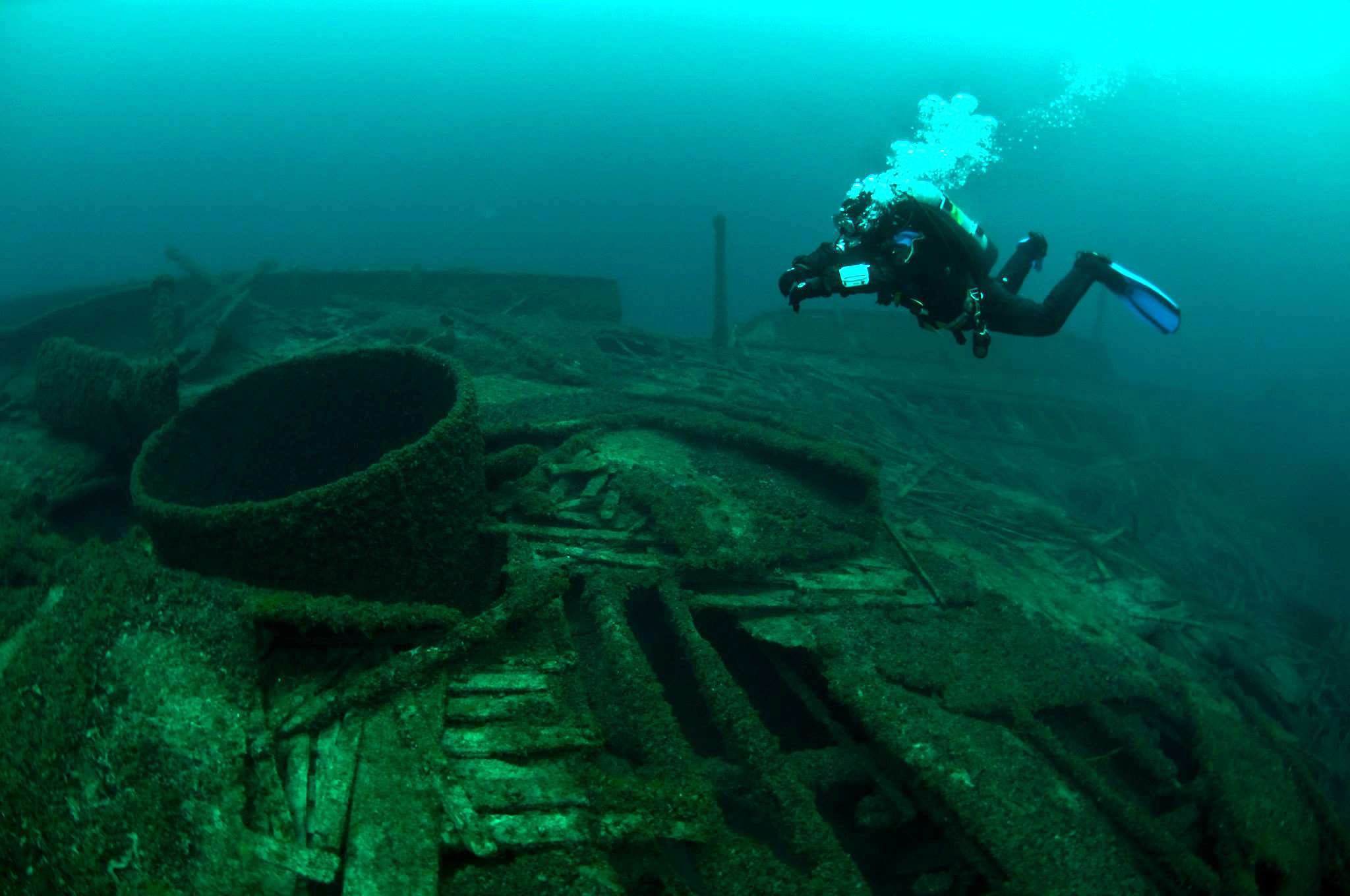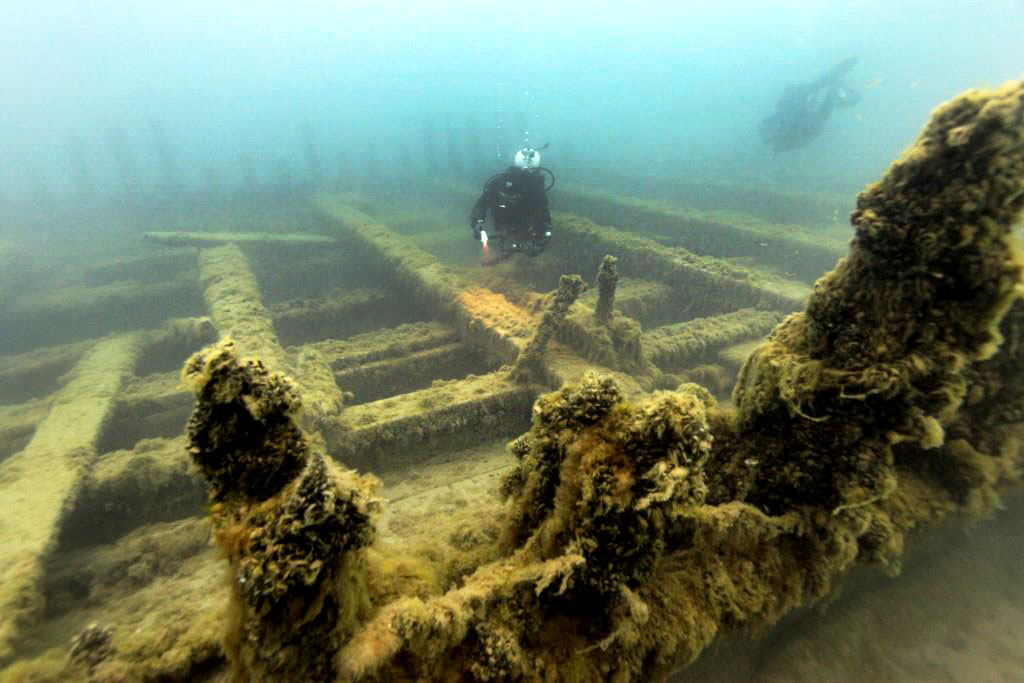On Saturday, September 29, 1906, the Great Lakes were struck with a gale. That same day, the barge, Car Ferry No. 2 was carrying twenty-eight railroad cars of iron ore and cedar telegraph poles from Peshtigo, Wisconsin to South Chicago. As the barge neared Chicago’s port, waves began to break and water made its way into the hold. Otto C. Olson, captain of the ship, threw down an anchor, and began to pump out the water. But the iron ore was too heavy. The ship flipped.
Now, more than a hundred years later, a group of Chicagoans have come together to tell the story of this shipwreck and the many others in Lake Michigan. The Underwater Archaeological Society of Chicago (UASC) meets on the last Wednesday of every month in the Chicago Maritime Museum (located since its opening in June 2016 on the lower levels of the Bridgeport Art Center). The trappings are modest: a podium, rows of folding chairs, a few snacks laid out on a folding table. The mission, though, is ambitious: to unearth (or more aptly, dredge up) and preserve stories of Lake Michigan shipwrecks like that of Car Ferry No. 2 and its crew.
Chicago and Lake Michigan aren’t the first places the uninitiated might associate with the word “shipwreck”: the South Pacific, maybe, or the Caribbean come to mind. But Chicago was once a major shipping hub: in its 1872 heyday, the number of ships arriving and leaving the Port of Chicago eclipsed any other port in North America, rivaling international strongholds like Hamburg and London. And where there are ships, there are shipwrecks. Of the estimated 6,000 maritime disasters on the Great Lakes, Lake Michigan was the site of nearly 1,500. Other ships were purposefully sunk (“scuttled”) as a means of disposal. Both kinds of wrecks litter the lake.
Members of the UASC are volunteers with an avocational interest in these wrecks and their history. Most of them are scuba divers too and like to dive down to the old shipwreck sites to investigate: take pictures and video, draw and scan with sonar. The UASC holds trainings to bring surveying skills up to the Nautical Archaeological Society’s standards—they recently held a class on underwater illustration. Then, together, the society compiles their findings into an official report, where the technical surveying skills sit side by side with their archival and historical research. Last year, they published one on the Car Ferry, a slim white volume titled “Project Report for the Avocational Archaeological Survey of the Railroad Car Ferry Number 2.”
Sam Polonetzky, UASC member and former coordinating engineer for the Chicago Department of Streets and Sanitation, hasn’t gone diving much lately: “Ever since I retired, I’ve been too busy,” he said. He’s been volunteering avidly at the Illinois Railway Museum. But he’s managed to stay involved with the UASC, undertaking much of the archival research for the Car Ferry report, where his railway expertise helped him uncover that the use of the car ferry, instead of a railway, to transfer its cargo was an attempt to physically bypass a conflict of corporate interest in the form of a rail transfer station operated by Andrew Carnegie’s U.S. Steel Corporation.
At the monthly meeting, after the socializing and hors d’oeuvres from 6:30pm –7pm, Polonetzky sits in the back row of folding chairs (“So I can get up to keep myself from talking if things get too heated”). At 7pm, the UASC gets down to business. They handle the usual concerns of a small organization: balancing budgets, getting new members, electing new leadership, figuring out what projects to move forward and what conferences to attend.
After the business section, there’s a presentation on a topic of interest. Sometimes it’s a guest (an expert or an author interested in Great Lakes maritime history) but this time it’s a member, Tony Kiefer, who takes the podium to present an old whodunit. He reads along to a video, which was edited together in 2000, to explain the story of the Zion Mystery Ship. His speech matches pace with the video, the music and images synchronizing with the dramatic reveals and plot twists, of which there are plenty. Seventeen years of practice with this presentation has paid off.
Kiefer guides the audience from the section of the Illinois Beach State Park in far north suburban Zion, down to the ship, submerged 400 feet out and twelve feet deep. The ship is a mystery because of its odd combination of traits: square nails (indicating the nineteenth century), but a propeller shaft (implying the twentieth century), a copper-plated hull (characteristic of an oceangoing vessel), a wood body, but with steel bulkheads. What was it? A minesweeper? Pleasure yacht? Fishing boat?
The ship, it turns out, was a subchaser, a rare breed. Subchasers were built during World War I as an answer to German U-boats. Steel was needed for larger ships: wooden subchasers could be produced fast and cheap in smaller shipyards.
An aerial photograph from 1937 of the beach, obtained by mail order, provides the centerpiece for the presentation’s climax, where all the clues come together and the ship’s identity is revealed. Through a series of stills, music swelling, we zoom in on the small, x-shaped black blur. It’s the ship, revealed after as much suspense as any crime show.
Steve Arnam interrupts from his folding chair in the back row. “That used to be a surf spot,” he says. “We called it ‘surfing the x.’”

Despite the late October chill, Arnam, a retired Chiago Public Schools teacher and self-professed “marine biologist by trade,” is dressed as if prepared for a summer surf session at “the x:” bright blue board shorts, earrings, a T-shirt with a picture of Lake Michigan and the logo of the “Southend Surf Club,” a calf tattoo of a seahorse, and a pair of bright blue plastic-rimmed glasses that sit perched between his eyebrows and his thinned mess of long blond hair.
Arnam learned to dive in warmer climes. He lived in the South Pacific, exploring shipwrecks from World War II and surfing. Jim Jarecki, another UASC member, learned to dive while in Mexico. He lied about his certification level and learned, sink-or-swim. He always thought he would be a “vacation diver,” like many are, until he found the UASC.
Lake Michigan is not the Pacific; for many months of the year, the water is too cold to dive. But Chicago winters have their advantages too, for scholarship if not for diving. UASC member Tom Palmisano spends the indoor months reading about the history of shipping on the Great Lakes. The diving keeps the reading interesting, and vice versa. Long winters, ample libraries, and a lack of warm weather beachside distractions lend themselves to the laborious archival research that makes up a good part of the UASC’s work. They are, after all, not just a diving club; they’re an archaeological society.
At the end of the meeting, after Kiefer’s presentation, the UASC screens a TV news segment about the 1991 vandalism of the Wells Burt, a ship that sank on May 21, 1883, en route from Buffalo to Chicago with a load of coal. Silhouetted scuba divers reenact the thieves’ mischief. The members shake their heads. Kieth Pearson jokes that he’s the culprit: “What’s the statute of limitations on that again?”
After the presentations are finished and the leftover hors d’oeuvres are packed, the Society adjourns to Ricobene’s, ordering pitchers of beer and plates of what one member affectionately calls “grease.” The conversation moves from old stories about college to old stories about ships. Jarecki, who holds a certificate in museum studies from the University of Chicago and is on the board of the Chicago Maritime Museum, is goaded into pulling out his party trick: he can name a historic event for almost any day of the calendar year. Then, the subject shifts to the contemporary: is it legal to remove zebra mussels from shipwrecks? The verdict: you need a permit.
The exchange is a one-two punch of the changing times in the world of Great Lakes shipwreck exploration. Zebra mussels, Arnam explains, are an invasive species, which, these days, encrust every wreck. Regulations surround the wrecks too, more and more ever since Ronald Reagan put pen to paper to sign the Abandoned Shipwrecks Act of 1987 into law, giving ownership of all abandoned ships to the state in which they’re submerged. The pre-Act days are the Wild West era, when the draw was more about looting and less about the intangible appeal of history. Things have changed: “Most people started out diving to loot, and now do preservation,” says Arnam.
The post-meeting Ricobene’s session wraps up; the pitchers are finished, and the members go home. But the Society’s work isn’t finished—their current project is a ship they call the “Mystery Wreck” (aren’t they all?), which lies seven miles north of Hammond, Indiana. They’re not sure what it is, and they haven’t seen one like it before. It looks like it’s a wooden boat from the nineteenth century, but there’s no indication of sail or mechanical power. It might be a barge. Dean Nolan, the sitting president of the UASC, hopes that, when they figure it all out, they’ll publish a report. But for now, it’s another of the UASC’s maritime mysteries waiting to be dredged up.
The Underwater Archaeological Society of Chicago meets on the last Wednesday of every month from 6:30pm-9pm at 1200 W. 35th St. Ste. OE5010. Meetings are free and open to the public; membership is $40.
Support community journalism by donating to South Side Weekly

